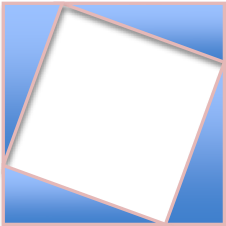PYTHAGORAS’ RULE
The diagram

is made up of four triangles, each of sides a, b and c, labelled in increasing length. The whole makes a square of side (a+b). The inside square is c by c; the four triangles are each of area a.b/2. The white square and the four blue triangles make the whole square:
So (a+b)² = c² + 4 (½ ab)
Expanding a²+2ab+ b² = c² + 2ab
Cancelling the two equal terms, we get
a²+ b² = c² which is what Pythagoras said.
There is an interesting collection of Pythagorean triangles with sides of integer length. The most famous, most commonly quoted one is 3,4,5 [check: 3²+4²=9+16=25=5²] and you are encouraged to find some of your own. This was once a GCSE project problem, back in the days when coursework was part of a GCSE in Maths.
Here is a table to fill in, or to copy and fill in:
Note that (C-B)(C+B) = C²-B² = A², so there are two columns that multiply together to suggest the A value.
Here’s a similar table, again giving you the first such line that uses numbers over a hundred:
Assuming that your browser will reproduce what I tried to tabulate, you will find many patterns in the columns. There are similar tables with C-B of 4 and 16, but they produce what I call Pythagorean triples that you have seen before, which are therefore deemed uninteresting. A boring triple has a common factor, such as [6,8,10]; these are also uninteresting.
Here’s another way of viewing some of the triples, still concentrating on keeping c-b constant: again, fill it in:
This generates no new ones from the previous sets, but it is a different way to view the triples. The difference between C and B values in adjacent rows goes up by 4 in both of these, implying that you should be able to find other sets with c-b equal to an odd square—you should try the 9s and perhaps the 81s (start with [41, -40, 9], reach [153, 72, 135]; then recognise this last triple as ‘boring’ because all the numbers divide by nine).
Count all the non-boring triples using one and two digit numbers; there are about thirty.
Textbooks that refer to this give an ‘answer’ that uses a generating function—a process that will ‘find’ all the triples without repetition. This starts from the observation that one of each triple is even and the other two are odd (prove, please that the other combinations of odd and even are either boring or impossible). If you call all of these even numbers 2st. you can show that t²-s² and t²+s² are the other members of any triple, using (t+s)(t-s) to generate t²-s², of course. You also find that, if you always choose t bigger than if s is odd, then t is only even; similarly, when s is even, t is (still bigger, and) only odd. I’m not showing you this on purpose, as it rather spoils the fun to be had.
By the time you have played awhile, one of the things well remembered is that the difference of two squares is a sum times a difference, i.e. c²-b² = (c-b)(c+b) and t²-s²=(t+s)(t-s). If nothing else.
One more thing is a great help when playing with these—your calculator. Somewhere on your machine is a button labelled Rec() or R->P and next to it is usually Pol() or P->R. Some machines also need you to find the comma key, often just above the digit keys. Rec and Pol are often second function + and x. Try Rec(3,4) and my machine says 5 immediately. Many machines say r=5; most don’t require you to close the brackets. A few also say theta, θ, (that’s Unicode character F071) is 53.13. Degrees, of course: magic trigonometry! Try Rec(5,12) and see r=13. For the purposes of playing with Pythagorean triples, this is perfect.
DJS 20130121
Here are some ideas to test out, as extension material, I think all of which is well beyond GCSE level 8:
1 Pythagorean Quads; these satisfy a²+b²+c²=d². I’ll give you the ‘first’ of these, [1,2,2,3]. Find another ten quads, using numbers below 30. What you did before helps a lot.
2 Prove that d is always odd or the set is boring, being divisible by two.
3 Prove that only one of {a,b,c} is odd for all non-boring quads.
4 Pythagorean Quints satisfy a²+b²+c²+d²=e². Find out how the last proof is extended for non-boring quints – is there one odd only in {a,b,c,d}? Can there possibly be three or even (haha) four odds?
5 Extend that proof to the general case.
Here’s table headings to use for the generating function:
s t 2st tt-ss ss+tt A B C
This Pythagoras.docx is a link to my file, but I have no idea if you can access it. Mail and ask, please (or suggest to me what to do, ‘cos it ain’t working for me within iWeb). Mail to david@scoins.net (of course, what else would it be?
